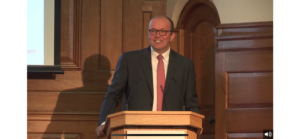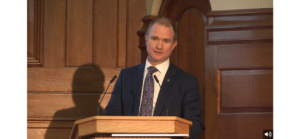UK Equity Release Summit emphasises importance of green equity release

The Equity Release Summit was held on 12 May 2022, as the UK’s annual landmark event bringing together leading players from the UK, European and international equity release industry, with the first plenary session of the day held on the theme of green equity release.
Opening the Summit, David Burrowes, Chairman of the UK’s Equity Release Council, noted that the event brought together industry professionals from around the world, including from the USA, Sweden, Spain and The Netherlands, among others. He recalled that the last event two years ago had been held on the cusp of a national lockdown, and that now the industry was again able to come together to network and to take part in discussions, noting that it had been very much “on the front foot” in bringing solutions.
David highlighted that “property wealth is key to enriching the lives of so many people in this country, whether for a more comfortable retirement, green equity release, to help younger members of the family get on the property ladder, or to pay for a higher standard of later life social care”. He noted that there are a myriad of other uses, including “simply giving happiness in later life. If wealth is unlocked safely, using all the safeguards of the standards that we are rightly proud of, equity release can transform the lives of so many people”.
Coming to the last two years, David recalled that “as an industry, we have not gone into hiding but during lockdown we were able to remain operational, and since then we have grown and evolved”. He mentioned that carrying out valuations during the lockdown had been a challenge, in view of the use of predominantly face to face financial advice and the mandatory requirement for in-person legal advice. He recalled that the Council had quickly brought together the funders, providers, distributors and solicitors and others to temporarily enable this. Overall, he saw that “the industry showed real resilience during this time and it prompted more flexible ways of working”.

Bernie Hickman, CEO of Legal & General Retail, as the main sponsor of the event, spoke of the “unashamedly positive case for the good that equity release achieves for customers and society”. He highlighted that “L&G is a big believer in the importance of businesses like ours in playing a prominent role in addressing the big challenges facing society. Being socially useful doesn’t mean being less profitable, in fact it helps sustain profits over the long term as we become more relevant to our customers and inspire people with our purpose and our social values. We are passionate about addressing the biggest challenges of our generation, the biggest ones being tackling climate chance and the more immediate challenges of the housing affordability crisis and, looming large, the cost of living crisis, which is why we are such big supporters of equity release through later life lending. We can see that, with good advice and family involvement, equity release can play an important role in addressing all these challenges while also helping to boost economic growth in the UK”.
He underlined that, as compared to passing on property to heirs, “a lifetime mortgage can achieve a much better outcome as a way to provide a legacy while alive, much earlier and at a much more useful time”, and that the giver would then have “a chance to see the outcome of a life-changing gift”.
He emphasised that “equity release isn’t right for everyone but where it is appropriate and accompanied by high quality advice it transforms lives and brings dignity, security and greater enjoyment in retirement”. He noted that those who do take out an equity release product are prepared to recommend it to others, with 90% in a survey saying they would do so. “With pension provision falling and the cost of living rising, more people will need to supplement their retirement finances with access to housing equity in the years to come,” he predicted.

Focus on Green Equity Release
The first plenary session was on the topic of Green Equity Release, which looked at the green deal and the role of housing wealth and equity release, retrofitting the ageing housing stock and the potential for equity release innovation.
Emma Harvey, Programme Director at the Green Finance Institute, warned that we are in the midst of a climate crisis and there was a need to act now. She saw that the commercial and corporate world was “making a move for the environmental agenda” and that the finance sector was one of the sectors at the forefront of this. She explained that she saw green finance from two perspectives, firstly “greening finance” which covered managing the risks associated with the transition to net zero, disclosure and taxonomies, for example, and secondly “financing green” which referred to mobilising capital to design and develop new financial products that generate revenues and lead to positive environmental outcomes.

She highlighted that buildings in the UK are responsible for 23% of emissions, and that most of these were from home, from heating and powering properties. She noted that the UK Climate Change Committee had estimated that £250 billion of investment would be needed to decarbonise homes, and that private investment is “absolutely necessary”. This is why the Green Finance Institute established the Coalition for the Energy Efficiency of Buildings at the end of 2019, she commented, to identify barriers to investment into decarbonising properties and how investment could help address those barriers.
Emma explained that green mortgages were currently the “poster child” of green home financing, with the number of products on the market now having reached “double digits” and some of these had adopted the Green Finance Institute’s green finance principles. She added that green equity release solutions were also coming to the market. In terms of the way forward, she saw that a range of solutions were needed, including data solutions, to gather momentum to share best practices, and that there needs to be collaboration and awareness raising with consumers.

Benet Northcote, co-founder of Intentio Finance, took the view that “every equity release product will need to become green very quickly if we are to avoid the worst effects of climate change”. He noted there was a lot of discussion about ESG and its importance but considered that this “will not drive change fast enough on its own”. He thought it was essential that financial institutions understand the impact that they have on the world and to look at the tools to make a real world impact.
With regard to the various schemes seen in recent years on retrofitting, solar panels and others, Benet saw that “they have all largely failed at scale”. He suggested that one of the questions that needs to be asked is “what is going to make the consumer want to do this and have the improvements made to their home?”
Steve Norris, Chairman at Soho Estate Limited, recalled that in the UK there was £5.2 trillion of real estate equity and that “it’s about your own costs”, anticipating that energy costs were likely to rise substantially in the next year or two. He considered that “there is something unique we can do with a product like equity release” and noted that some other countries like Italy were paying 110% of the costs of installing equipment such as solar panels. For those taking out equity release for green improvements, he noted that even on the basis of rolled up interest “the asset is worth more than if you had done nothing”.

Asked what a green lifetime mortgage could look like, Emma noted that that this could improve energy efficiency, leading to lower interest rates and cash back, as well as non-financial benefits such as free energy efficiency assessments, if part of the funds had gone to this or climate resilience improvements.
In terms of how green equity release mortgages could become the norm, Benet underlined that changes bring a lot of inconvenience, and so he saw that “the product has to be wrapped up in the impact on lifestyle”. He considered that many equity release customers may be under a degree of financial stress and were older than average, so needed to get over those barriers.

Looking ahead, Steve recommended dividing the market into new build and retrofit, where the rationale for the latter was taking a product that is no longer fit for purpose and making it one. On new build, he noted that ESG is now critical in housing markets. He summed up his view by saying “the closer you get to being energy self-sufficient the better it is for the consumer in the home. This will all be at the top of the agenda in terms of the attractiveness of the product and bringing it to market”.
Concluding the session, and in response to questions from the floor on the prospects for green solutions, Emma noted that “this challenge is incredibly complex. Finance is not going to solve it, technology is not going to solve it and policy is not going to solve it in and of itself. We need to have all these different pieces coming together and that is where collaborating across different sectors, working with normally your competitors, to help build this market is so critical. Finance is not going to solve the problem but, when that demand comes through, we need to have the products ready so they are not a blocker to solving this challenge”.
A link to the Lender’s Handbook published by the Green Finance Institute/CEEB last year is available here. The Handbook aims to inform lenders about different green home retrofit solutions and technologies by providing a profile of the options available and their associated opportunities and risks, as well as quality assurance standards.